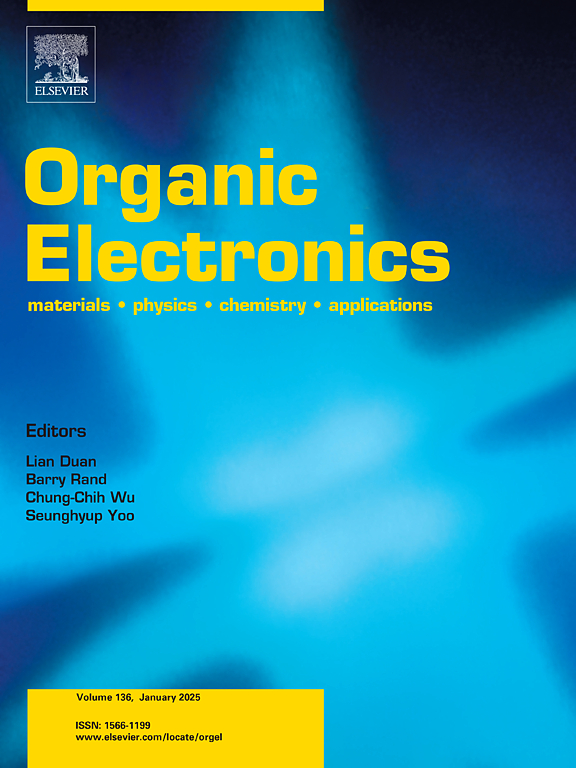Effect of emissive ligand number on the optoelectronic properties of dendronised heteroleptic green emitting iridium(III) complexes
IF 2.7
4区 工程技术
Q3 MATERIALS SCIENCE, MULTIDISCIPLINARY
引用次数: 0
Abstract
We compare first- and second-generation dendrimers with biphenyl-based dendrons and green emissive homoleptic or heteroleptic fac-iridium(III) complex cores. The core complexes had one, two or three 2-phenylpyridyl ligands, which were responsible for the emission of light. The dendronised co-ligand, 5-phenyl-1-methyl-3-n-propyl-1H-1,2,4-triazole, was found not to contribute to the colour of the emission. The first- and second-generation dendrimers that had two emissive 2-phenylpyridyl ligands were found to have high solution photoluminescence quantum yields (PLQYs) of nearly 90 % whereas the homoleptic dendrimers and the one with a single emissive ligand had PLQYs of around 70 %. The PLQY values decreased in the solid-state, with the second-generation dendrimer with a single emissive ligand found to have the highest neat film PLQY of 55 %. This was attributed to the dendronised co-ligand acting as a self-host to reduce the intermolecular interactions that lead to the quenching of the luminescence. Organic light-emitting diodes (OLEDs) composed of neat films of the dendrimers had relatively poor performance, with unbalanced charge transport and a maximum external quantum efficiency (EQE) of 6.5 % for the second-generation dendrimer with a single emissive ligand. OLEDs with an emissive layer composed of a blend of the dendrimers in tris(4-carbazoyl-9-ylphenyl)amine all had similar current density-voltage characteristics, with the EQEs following the observed trend in the solution PLQY values. The OLED with the blend emissive layer containing the first-generation dendrimer with two emissive ligands was found to have an EQE of up to 14.1 %. Thus, both dendrimer generation and the number of emissive ligands can be used to control OLED performance.

发射配体数目对树突状异色绿发光铱(III)配合物光电性能的影响
我们比较了第一代和第二代树状大分子与基于联苯的树突和绿色发射的同效或异效面-铱(III)复合物核心。核心配合物有一个、两个或三个2-苯基吡啶配体,这些配体负责发光。发现树突化的共配体5-苯基-1-甲基-3-n-丙基- 1h -1,2,4-三唑对发射物的颜色没有影响。具有两个发光的2-苯基吡啶配体的第一代和第二代树状大分子具有接近90%的高溶液光致发光量子产率(PLQYs),而同源性树状大分子和具有单一发光配体的树状大分子的PLQYs约为70%。在固态中,PLQY值有所下降,具有单一发射配体的第二代树状大分子具有最高的整齐薄膜PLQY,为55%。这是由于树突化的共配体作为自宿主,减少了导致发光猝灭的分子间相互作用。由树状大分子整齐薄膜组成的有机发光二极管(oled)性能相对较差,电荷输运不平衡,具有单一发射配体的第二代树状大分子的最大外量子效率(EQE)为6.5%。由三(4-咔唑基-9-苯基)胺中树突状分子组成的发光层的oled具有相似的电流密度-电压特性,其EQEs遵循溶液PLQY值的观察趋势。发现含有两种发光配体的第一代树状聚合物的混合发光层的OLED具有高达14.1%的EQE。因此,枝状大分子的生成和发射配体的数量都可以用来控制OLED的性能。
本文章由计算机程序翻译,如有差异,请以英文原文为准。
求助全文
约1分钟内获得全文
求助全文
来源期刊

Organic Electronics
工程技术-材料科学:综合
CiteScore
6.60
自引率
6.20%
发文量
238
审稿时长
44 days
期刊介绍:
Organic Electronics is a journal whose primary interdisciplinary focus is on materials and phenomena related to organic devices such as light emitting diodes, thin film transistors, photovoltaic cells, sensors, memories, etc.
Papers suitable for publication in this journal cover such topics as photoconductive and electronic properties of organic materials, thin film structures and characterization in the context of organic devices, charge and exciton transport, organic electronic and optoelectronic devices.
 求助内容:
求助内容: 应助结果提醒方式:
应助结果提醒方式:


